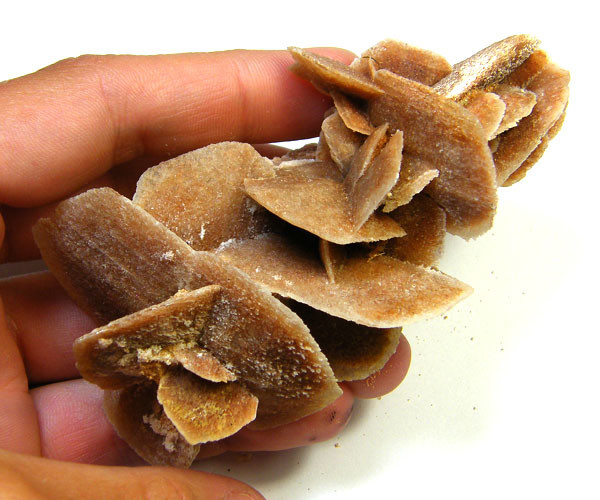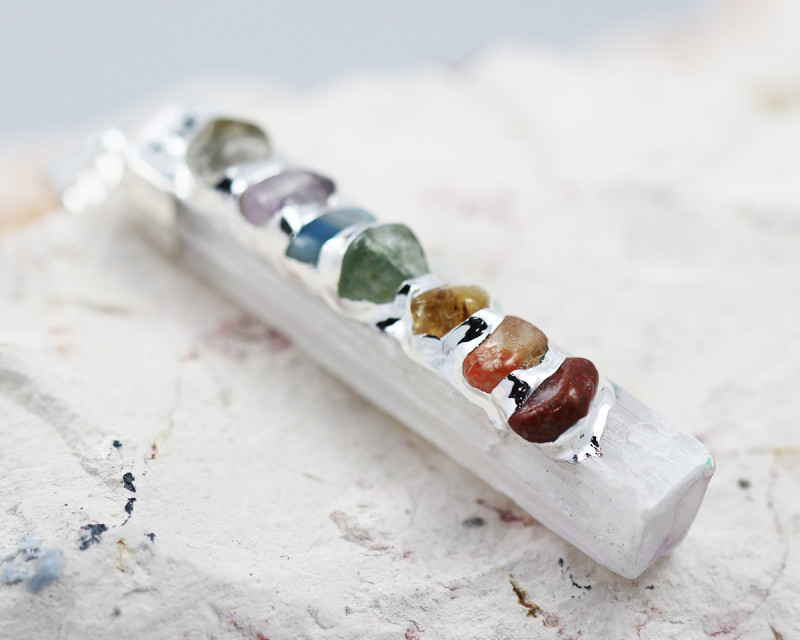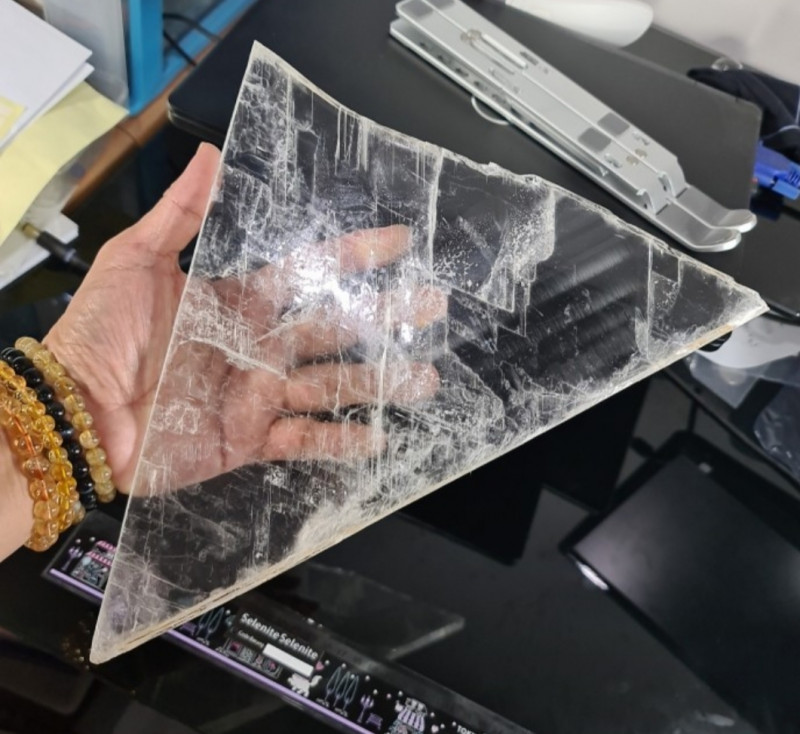Selenite Gemstone: Properties, Meanings, Uses & Benefits
 Selenite gemstones are transparent gypsum crystals known for their beautiful shapes and spiritual cleansing abilities. These crystals are usually colorless, white, or gray.
Selenite gemstones are transparent gypsum crystals known for their beautiful shapes and spiritual cleansing abilities. These crystals are usually colorless, white, or gray.
Are gypsum and selenite the same, then? Yes and no. Selenite is a form of gypsum, so all selenite is gypsum. However, alabaster is another gypsum variety distinct from selenite, so not all gypsum is selenite.
The selenite crystal is also celebrated for its massive sizes, ranking among the largest found on Earth. One specimen found in Mexico was reportedly almost 40 feet (12 meters) tall!
If that doesn’t impress you, just wait. In this article, we’ll fill you in on all the selenite crystal properties, varieties, and healing uses that make this gem so impressive.

About Selenite Stone
Selenite is a semi-precious gemstone with a slight glow that led to its nickname “liquid light.” It’s also called a moon stone, though it’s not related to moonstone.
Is selenite a birthstone? No, but it is a zodiac stone for Taurus, Gemini, and Cancer. Selenite is also a star stone for, unsurprisingly, the moon!
Selenite Specifications & Characteristics
Selenite’s chemical formula is CaSO4·2H2O, meaning it’s a hydrous calcium sulfate. On the Mohs mineral hardness scale, selenite gypsum ranks at a very low 2. Outside of gemstones, selenite mineral uses come in handy for plaster, cement, and fertilizer.
Selenite is commonly mistaken for calcite. How can you tell if selenite is real?
The easiest test is hardness, as selenite is softer than calcite. Plus, selenite density is around 2.3, while calcite density is 2.71.
Almost all selenites are transparent, and they only appear translucent to opaque from inclusions, element impurities, and natural sand coatings.
Find all the selenite mineral properties below:
Mohs hardness: 2; 3 (satin spar)
Color: Usually colorless, white, or gray; Can be yellow, red, brown, or blue from impurities
Crystal structure: Monoclinic
Luster: Waxy or sub-vitreous, pearly on cleavage; Silky (satin spar)
Transparency: Transparent to opaque
Refractive index: 1.52-1.53
Density: 2.25-2.35
Cleavage: Perfect on [010]; Distinct/Strong on [100] and [011]
Fracture: Micaceous or fibrous
Streak: White
Luminescence: Sometimes phosphorescent; Often fluorescent in center “hourglass” zone - usually tan or light green in LW-UV & SW-UV
Optical Effects: Chatoyancy & “television stone” effect (satin spar)

Types of Selenite
Gypsum minerals can form an array of crystal shapes. Selenite varieties are named for some of its beautiful and unique shapes. Some classify selenite separately from the other shapes, but we’ll categorize them under selenite.
First, what is desert rose selenite?

Desert Rose
Desert rose selenite is a collection of rounded crystal clusters shaped like rose petals radiating out from a central point. Found in deserts, the crystals have lots of sand in and around them, sometimes as druze.
The edges of the “petals” usually have a pearly or glass-like luster. Rusty-red ones are dull in luster.
Other names include:
Gypsum Rose/Rosette
Selenite Rose
Rose Rock
Sand Rose
Sahara Rose
Barite can also create a desert-rose shape or combine with a desert rose selenite. The edges of selenite desert roses are sharper, but barite desert rose crystals are harder.

Satin Spar
Satin spar is a translucent, silky, and fibrous crystal that may be milky white or peach-colored and forms prismatic crystals. The fibers inside can give the stone a “cat’s eye” effect (chatoyancy).
If cut and polished correctly, satin spar will also display a “television stone” effect where images under the stone look like they’re on its surface!
Many gemologists classify satin spar as one of three gypsum varieties, beside selenite and alabaster. For this guide, we’ll put satin spar under the selenite umbrella.
Why is selenite called satin spar, anyway? “Satin” refers to this variety’s silky to pearly luster. “Spar” is an old mining term for pale crystals with easily recognizable crystal faces and a shiny, smooth appearance.
Notably, satin spar also has a higher hardness ranking (3) than other selenites.

Gypsum Flower
Gypsum flower is a fibrous selenite crystal cluster with various shapes but mostly known for its curved petal-like crystal shape. Gypsum flower’s “petals” are more non-uniform in direction and size, while desert rose’s “petals” resemble a blooming rose. Gypsum flowers are also more lustrous.
Gypsum flower crystals are often twinned. “Twinning” is when a crystal starts to grow one way, then switches direction to create a symmetrical “twin” crystal attached.
These twinned crystals can also curve, creating shapes such as:
Ram’s horns
Swallowtail
Duck-bill
Fishtail
Arrowhead
Next, let’s shift gears to examine selenite’s metaphysical properties!

Selenite Crystal Meaning & History
Selenite symbolizes light, clarity, and the divine feminine. The selenite palm stone meaning is one of cleansing negativity.
The name “selenite” derives from the Greek selēnitēs lithos, meaning “stone of the moon.” There are a few theories about the reason behind this naming:
Pearly luster on cleavages resembles a glowing moon
Historical belief that selenite waned and waxed with the moon’s cycle
Selenite’s common use as material for moon-viewing windows
In honor of the Greek goddess of the moon, Selene (also called Artemis)

History
The first selenite uses were largely carvings. Egyptians 5,000 years ago used gypsum as wall plaster, now referred to as Plaster of Paris.
Gypsum and selenite were used interchangeably until the 1400s, when selenite began exclusively describing transparent gypsum crystals.
The first record of selenite’s name was in the 1747 book Mineralogia, eller Mineralriket by Swedish scientist J.G. Wallerius.
American mineralogist George F. Kunz wrote about egg-shaped satin spar stones from Egypt in 1913, stating that Egyptians called them “Pharaoh’s Eggs” and believed they were protective.
Speaking of mystical properties, what is the selenite stone good for?

Selenite Healing Properties
Selenite is considered one of the most powerful healing stones for cleansing, protection, and clarifying. These selenite properties are similar to other colorless gems.
Selenite is one of the most common crystals for cleansing stones, a process of ridding built-up negative energies stored inside the stone so it can function optimally for healing.
In esoteric shops, you may see a selenite charging plate or crystal. But what is a selenite charging crystal? These are spiritual tools for cleansing and “charging” another gemstone. Charging a crystal gives it greater healing vibrations for longer.
What are the physical, emotional, and chakra selenite benefits?
Physical Healing
Physical selenite stone benefits may include improving calcium absorption and flexibility. A selenite wand is also common for kneading, or putting the point on pressure points to relieve pain.
Additionally, selenite is said to enhance fertility, plus ensure the mother and baby’s health during pregnancy.
Emotional Healing
This “Stone of Mental Clarity” can stimulate the mind while organizing thoughts, allowing for insights into complex situations. Selenite bracelet benefits are said to enhance peace and self-awareness for wiser decision-making.
In relationships, selenite can encourage forgiveness and honesty while dispelling envy. Gypsum flowers are popular for filling groups with reassuring, loving energies.
Chakra Healing
Chakra stones resolve the negative symptoms of a blocked chakra, or energy center, by opening the chakra. This allows the chakra’s positive symptoms to emerge.
Selenite chakra stones are best for the third eye chakra. Located on your forehead, the third eye chakra governs spiritual awareness, intuition, and understanding of the world.
If you feel stuck in your thoughts or disconnected, your third eye may be blocked. Use selenite, and your third eye opening will help you access greater spiritual wisdom.
Can you meditate with selenite? We recommend it! Meditation is a common and useful method for chakra healing.

Selenite Gemstone Properties
The factors that influence selenite’s value include its color, cut, transparency, luster, and treatments.
Color
Selenite colors can vary and sometimes show marble-like patterns. Different colors come from various causes, but each variety has typical colors:
Selenite: Colorless, white, or pale blue
Satin Spar: White or peach
Desert Rose: Tan, brown, rusty-red, dusty rose
Gypsum Flower: White, yellow, tan, green, or gray
Desert rose and gypsum flower often take on the color of the sand attached.
Cut
Selenite stones are almost never faceted. Chatoyant satin spar must be cut into a cabochon to display the “cat’s eye” effect. Carved selenite towers and wall hangings are also common.
Most have unique shapes like a selenite bowl or plate. Many shops sell uncut, gypsum flower or desert rose selenite raw crystal specimens for their natural beauty, either as decor in a selenite crystal necklace.
Transparency & Luster
Transparent selenite is rarer and most valuable. Luster-wise, pearly to vitreous specimens are most valuable, and dull specimens are least valuable.
Treatments
Common treatments for selenite are dyeing, bleaching, and coating. Jewelers may dye or bleach selenite to improve its color. Durability-enhancing treatments like surface coating either won’t change the value or will actually increase value.

Selenite Formation & Sources
Transparent selenite and gypsum flower crystals form inside ancient limestone caves. Water seeps through the limestones, gathering minerals (namely sulfate and calcium). Heat from magma below makes the water precipitate and the minerals crystallize.
How fast do selenite crystals grow? Very slowly. Transparent selenites in Mexico’s Cave of the Crystals took over 500,000 years to form, according to scientists. Gypsum flower and desert rose, however, form in only decades to centuries.
Desert rose selenites form in dry, sandy areas like deserts, clay beds, or evaporating salt basins. The environment must have seasonal water flow and calcium sulfate.
Water collects calcium sulfate and condenses in the sand. The water precipitates, leaving behind crystal clusters. Wind and other forces cause sand to fill and/or coat the crystal.
Mining Locations
Where is selenite found naturally? Besides the aforementioned Cave of the Crystals in Mexico, other notable deposits of selenite are in:
Argentina
Australia
Brazil
Chile
Greece
Italy
Japan
Mexico
Poland
Russia
Sahara Desert (desert roses)
USA (Utah, Colorado, New York)
Now, how much is selenite worth?

Selenite Price & Value
The overall selenite crystal price is pretty affordable. Most products are carvings or raw selenite crystals. Selenite mineral specimens are typically $0.04-$0.16 per carat.
Here are the price ranges for common selenite products at wholesale:
Wands: $5-$20 (around $0.01 per carat)
Hearts: $5-$10 for small and $30-$50 for large (both $0.02-$0.05 per carat)
Pyramids: $15-$25 ($0.02-$0.04 per carat)
Spheres: $20-$60 ($0.01-$0.02 per carat)
Higher-priced pyramids or wands are often due to the addition of LED bulbs to create selenite lamps.

Selenite Care and Maintenance
Gemstone care is always important, but especially so for a delicate stone like selenite.
Can selenite go in water? Any gypsum will dissolve if left to soak in water. That’s why the safest way to clean selenite is by gently scrubbing the stone with a soft toothbrush or microfiber cloth.
What do you do if you put selenite in water? Don’t panic! Simply take it out and completely dry it as soon as you can.
For polishing, how do you shine selenite? We recommend taking it to a professional jeweler. However, some polish selenite at home by sanding with 600-grit sandpaper or lower, then applying an aluminum oxide polishing paste and rubbing it in with soft leather.
Looking at your own health, is selenite toxic? Selenite stones are not toxic, as they don’t contain selenium. Sodium selenite (containing selenium and unrelated to selenite crystals) can be toxic.

Let Your Spirit Shine with Selenite!
By now, you can see selenite has a lot of impressive qualities. Given its massive crystals, beautiful floral shapes, and powerful healing properties, selenite is a crystal worth cherishing.
Spiritually, getting a selenite crystal could be your first step toward higher awareness and accessing your inner moon goddess.
Was this article helpful?
Ross Sedawie
- Written - 16th Apr 2022
- Edited - 1st Aug 2023

















